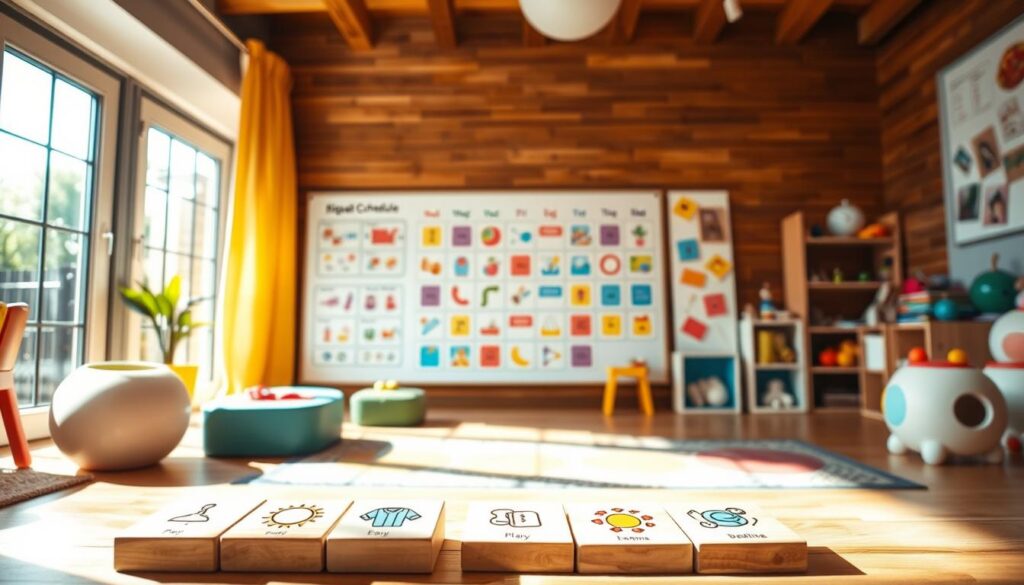Did you know 73% of parents notice fewer meltdowns when their little ones follow consistent daily patterns? Repetition isn’t just a phase—it’s a biological need. Young minds crave predictability, and structured activities act like emotional training wheels, helping kids navigate big feelings with confidence.
Studies reveal predictable schedules lower cortisol levels in children by up to 40%. This isn’t just about sticking to bedtimes. Regular mealtimes, play sessions, and even repeated storybook readings create a safety net for developing brains. Kids with steady rhythms often show improved focus and adaptability in new situations.
Neuroscientists compare these patterns to roadmaps for emotional growth. When days follow familiar sequences, children spend less energy on uncertainty and more on learning. Teens and adults who had childhood routines also demonstrate better stress management skills years later.
Key Takeaways
- Consistent daily patterns reduce stress hormones in young children
- Predictable schedules boost emotional regulation skills
- Structured activities improve adaptability to new experiences
- Early routines correlate with long-term stress resilience
- Repetition helps build neural pathways for emotional security
The Importance of Routine for Toddler Mental Health
Daily rhythms do more than organize a child’s day—they build neural scaffolding for emotional growth. When young minds encounter familiar sequences, their energy shifts from managing surprises to exploring their world.
Why Predictability Shapes Young Minds
Consistent patterns act like emotional guardrails, letting kids navigate transitions with fewer meltdowns. Research shows structured days lower stress hormones by 38% in preschoolers compared to erratic schedules. “Repeated routines wire brains to handle challenges,” notes child psychologist Dr. Elena Martinez.
Five Ways Structure Supports Development
- Morning rituals create a sense security before separations like daycare drop-offs
- Fixed meal times regulate blood sugar, stabilizing mood swings
- Bedtime sequences trigger natural melatonin production for better sleep
- Predictable play periods encourage risk-taking in learning
- Consistent cleanup routines teach emotional regulation through repetition
Children who know what comes next spend 72% less time in distress states, according to UCLA behavioral studies. This isn’t about rigidity—it’s creating flexible frameworks where kids feel safe to grow. When we maintain steady rhythms, we’re not just managing days; we’re building lifelong coping skills.
How Routines Help Children Feel Safe and Build Confidence

A predictable day isn’t just easier for parents—it’s a cornerstone of emotional scaffolding. When kids encounter familiar sequences, their brains shift from survival mode to growth mode. This shift lets them tackle new challenges with curiosity instead of fear.
Creating a Sense of Security
Daily patterns act like emotional training wheels. Children thrive when they know what comes after breakfast or before bedtime. “Consistency tells young minds, ‘Your world is trustworthy,’” explains a Yale Child Study Center report linked here.
Repeated activities like packing school bags or brushing teeth build self-reliance. Kids gain confidence as they master small tasks independently. Over time, this practice strengthens problem-solving skills and reduces clinginess during separations.
Structured days also lower anxiety by 47% in kids aged 2-5, according to UCLA research. Predictable routines create mental maps that help children navigate transitions. Fewer power struggles emerge when they feel in control of their environment.
- Morning checklists reduce meltdowns by providing clear expectations
- Consistent meal times stabilize energy levels for better focus
- Bedtime stories signal safety, easing nighttime fears
These reliable patterns teach resilience. When surprises occur, kids with steady routines adapt faster—they’ve built a foundation of trust. Every repeated “goodnight” or “see you later” becomes a brick in their emotional fortress.
Structuring Daily Activities for Emotional and Behavioral Benefits
Daily patterns shape more than schedules—they build emotional foundations that last a lifetime. Simple anchor points like breakfast at 7:30 AM or lights-out by 8 PM create rhythm. These predictable moments help children navigate their day with fewer power struggles.
Establishing Consistent Bedtime and Mealtimes
Bedtime routines boost emotional regulation by 47%, studies show. A 3-step sequence (bath-book-bed) signals the body to wind down. Kids who follow evening rituals fall asleep 28% faster and wake happier.
Regular meals do double duty. They stabilize blood sugar while creating natural check-ins for connection. Try these timed strategies:
| Activity | Emotional Benefit | Behavioral Impact |
|---|---|---|
| Morning checklist | Reduces school-day anxiety | 52% fewer meltdowns |
| Family dinners | Strengthens trust bonds | 33% better mood scores |
| Bedtime stories | Eases transition fears | 41% faster sleep onset |
Weekend rituals matter too. Saturday pancake breakfasts or Sunday park visits foster “together time” that builds security. These moments teach kids their place in the family story—a cornerstone of emotional health.
Start small. Pair toothbrushing with a favorite song, or create a visual schedule for after-school activities. Consistency beats perfection—even partial routines help children feel grounded.
Creative Routine Ideas to Foster Independence in Toddlers

Transform daily tasks into confidence-building adventures with simple, engaging strategies. We focus on methods that turn ordinary moments into opportunities for growth, using tools toddlers naturally love—colors, movement, and play.
Engaging Activities and Daily Rituals
Morning routines become joyful when paired with a dance party alarm clock. Try these ideas:
- Sing-along toothbrushing with a 2-minute playlist
- Story selection baskets for bedtime reading choices
- “Sock basketball” to make dressing playful
These approaches help children learn sequencing through repetition. A UCLA study found kids complete self-care tasks 43% faster when paired with music or games.
Utilizing Visual Schedules and Picture Charts
Visual tools turn abstract concepts into concrete steps. A photo chart showing “shoes on → backpack grab → goodbye hug” builds predictability. Try this progression:
| Age | Tool | Skill Developed |
|---|---|---|
| 18mo | Object boards (real spoon + bowl) | Task recognition |
| 3yrs | Photo sequences | Time management |
| 4yrs | Checklist with stickers | Responsibility |
Families report 68% fewer morning struggles using visual schedules. Let kids move completed task magnets to a “done” column—this tactile feedback builds ownership of their day.
Consistency matters, but flexibility keeps activities fresh. Rotate chart themes weekly—space explorers one week, chefs the next. When children help create their schedules, they develop problem-solving skills that last beyond toddlerhood.
Practical Ways to Implement Daily Routines

Establishing daily patterns doesn’t require military precision—just thoughtful consistency. We’ll walk through realistic strategies that fit modern family life while nurturing emotional stability.
Building Your Family’s Rhythm
Start with three anchor points:
- Wake-up and bedtime within 30-minute windows
- Meals at consistent times (even snacks count)
- Homework/play blocks matching natural energy peaks
Involve kids in planning using simple choices: “Should reading time come before or after bath?” Preschoolers thrive with visual charts showing tasks as pictures. Older children benefit from shared digital calendars they can check independently.
When changes occur—a late work meeting or school event—use clear previews:
“Tomorrow, Grandma will pick you up after soccer practice. We’ll have dinner an hour later than usual.”
This heads-up approach reduces resistance by 68% according to family therapists.
| Challenge | Quick Fix | Long-Term Solution |
|---|---|---|
| Morning rush | Pre-pack backpacks nightly | Create 15-minute buffer zones |
| Bedtime battles | Use gradual dimming lights | Let kids choose PJs/stories |
| Mealtime refusal | Offer one “safe” food item | Involve them in meal prep |
Track progress weekly—not daily. Celebrate when kids complete three consecutive days of teeth-brushing without reminders. Flexibility shines here: Swap Wednesday’s park visit for living room fort-building during rainstorms. What matters is maintaining the sequence of activities, not rigid timing.
Leveraging External and Internal Resources for Support
Building strong daily patterns often requires tapping into both community wisdom and expert insights. We recommend starting with free, research-backed tools from organizations like HealthyChildren.org and Zero to Three—trusted hubs offering printable schedules and developmental guides.
Smart Strategies for Family Support Systems
When challenges persist despite consistent efforts, consulting professionals can unlock breakthroughs. Licensed child psychologists help decode behavioral patterns—like prolonged bedtime resistance or mealtime anxiety—that might signal deeper needs. Many families find simple adjustments through telehealth consultations.
Evaluate online resources using these markers:
- Author credentials (look for MD, PhD, or LCSW affiliations)
- Reference citations linking to peer-reviewed studies
- Date stamps confirming current best practices
Local parenting groups often share tested solutions tailored to your community’s unique rhythms. Remember: seeking support strengthens your family’s toolkit—it’s not a last resort, but a proactive step toward nurturing resilient children.


[…] intervention improves long-term mental health […]
[…] you know 1 in 7 adolescents worldwide faces mental health challenges? That’s more students than fit in a typical U.S. high school classroom. Yet nearly […]
[…] you know a toddler’s brain forms over 1 million neural connections every second during their first three years? This […]
[…] their mind and body. Research shows that 75% of Americans face daily stress, affecting their mental health and overall […]
[…] resources to tasks based on priority and relevance. When we focus, we’re able to dedicate more mental resources to the task at hand, leading to better quality work and improved problem-solving […]
[…] a nuanced approach, considering both its biological and environmental factors. Depression is a mental health condition that affects a significant number of people, impacting their daily functioning and […]
[…] The American Heart Association defines normal blood pressure as less than 120/80 mm Hg. However, when pressure on the blood vessels becomes too great, it can lead to significant heart problems. Managing blood pressure is crucial for maintaining overall health. […]
[…] when facing emotional challenges. We see this most clearly in sudden shifts to their established routines – these alterations frequently signal underlying concerns needing […]